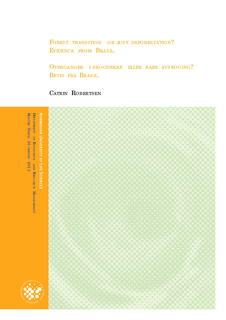| dc.description.abstract | Climate change is emerging as one of the greatest global challenges in the twenty first
century, and is the result of increasing levels of carbon dioxide and other greenhouse gases in the atmosphere. Deforestation is the third greatest contributor to greenhouse gas emissions,
and there is a growing consensus that Reduced Emissions from Deforestation and forest Degradation (REDD) should be included in a post-Kyoto agreement.
This thesis examines forest cover change in the Brazilian Amazon in light of the forest
transition theory, where the central idea is that deforested areas eventually will reforest. The relationship between deforestation and forest cover, as well as socioeconomic and biophysical
conditions is examined to determine whether patterns and trends in the Brazilian Amazon are consistent with theory.
Public data from various Brazilian sources (e.g. IBGE, INPE, IPEA) at municipality level is used to explain land cover change between 2000 and 2009. Deforestation data have been collected for 783 municipalities, but to ensure reliable results, 41 observations from 2001 have been excluded. The dataset is pooled, and OLS estimation is performed for different
specifications. Evidence of a forest transition relationship is found for forest cover. Municipalities with high forest cover will experience greater rates of deforestation. This effect is found to be stronger
at state level when results are tested for sensitivity to geographic aggregation. Results also indicate that poor municipalities have higher deforestation rates. Poor municipalities are often dependent on the forest to make a living, and thus do not have resources to avoid deforestation. A number of other factors have been controlled for in the analysis, and
explanatory variables such as distance to capital, population- and road density is found to have a clear impact on deforestation rates. | no_NO |
